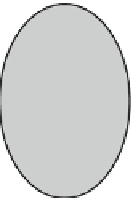Environmental Engineering Reference
In-Depth Information
Fig. 5.5
Example of squirrel
gage
Asyncronous AC machines, also called induction machines, have rotor windings
realized with conductors soldered together with two end rings, realizing what is
known as squirrel gage (see Fig.
5.5
). The interaction of the rotor conductors with
the rotating magnetic field generated by the stator windings induces electromotive
forces and thus currents in the rotor windings, which interact with the cause that
generates the same currents (Lenz's law)[
10
]. The consequence of that magnetic
mutual interaction is that also a rotor magnetic field is generated, rotating at the
same synchronous speed and with alternative poles. The attraction and repulsion
between the stator magnetic field with the rotor magnetic field generates an
electromagnetic torque, which is different from zero only when there is syn-
chronization between the two magnetic fields of rotor and stator, or in other words
when the two magnetic fields rotate at the same speed with respect to the stator or
the rotor and the rotor speed is different from the synchronous speed.
The working principle of the induction machines is based on the fact that rotor
currents are induced by the stator currents, and this is the main cause of losses in
the rotor windings, which makes these types of machines less efficient than other
brushless machines [
11
]. However, asynchronous machines are widely used and
their mass production makes them reliable and well developed, for that reason
their cost is quite low.
Synchronous AC machines have a stator similar to the asynchronous machines,
which has usually a three-phase stator winding. Whereas there are two types of
rotor structures: round cylindrical rotor and salient pole rotor as illustrated
schematically in Fig.
5.6
. The rotor field is generated by permanent magnets or a
DC current winding, as reported in the same figure. In the first case they are called
permanent-magnet synchronous AC machines.
The DC rotor winding is supplied with an external DC voltage by means of a
brush-ring system, similar to the brush-collector system for the DC electric
machine. The excitation of the rotor winding can also be obtained with a DC
generator, known as exciter, located on the rotating shaft, or other excitation
systems using AC exciter and solid state rectifiers.
In synchronous AC machines the synchronization between the stator and rotor
magnetic fields is achieved since the rotor magnetic field is fixed with respect to a
rotor observer and thus it operates at the same speed as the rotor, which is the same
speed of the stator magnetic field.



































